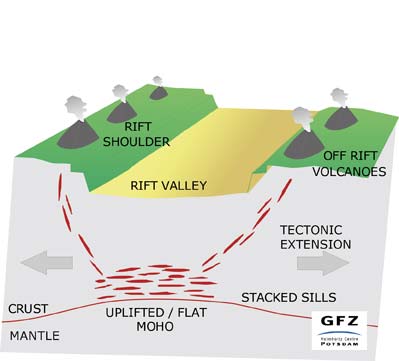Off-rift volcanoes explained

Schematic diagram illustrating the formation of off-rift volcanoes (graphics: R. Milkereit, GFZ)
Volcanoes often occur in rift valleys, within the rift itself or on the rift flanks as e.g. in East Africa. The magma responsible for this volcanism is formed in the upper mantle and ponds at the boundary between crust and mantle.
For many years, the question of why volcanoes develop outside the rift zone in an apparently unexpected location offset by tens of kilometers from the source of molten magma directly beneath the rift has remained unanswered. A team of scientists from the GFZ German Research Centre for Geosciences, University of Southampton and University Roma Tre (Italy) have shown that the pattern of stresses in the crust changes when the crust thins due to stretching and becomes gravitationally unloaded.
As a consequence of this stress pattern, the path of the magma pockets ascending from the ponding zone is deviated diagonally to the sides of the rift. Eventually, the magma pockets emerge at distances of tens, sometime hundreds of kilometers from the rift axis, creating the so-called off-rift volcanoes.
The scientists used a numerical model that simulates the propagation of the magma pockets, called dikes, to demonstrate a previously unknown control of rift topography on the trajectory of magma transport.
The surface location of the volcanoes depend on the geometry of the rift valleys, explains GFZ researcher Francesco Maccaferri: “We find that in broad, shallow rift valleys, the magma will ascend vertically above the source of magma. In deep, narrow valleys the modification of the stress pattern is very intense and the magma path is strongly deviated.” Since in the latter case the initial path of the dikes is almost horizontal, in extreme cases the magma can arrest as a horizontal intrusion and form a pile of stacked sheet-like bodies without any surface volcanism. This is confirmed in rift valleys around the world.
The phenomenon is a dynamic one: “If the tectonic extension continues and the rift reaches a mature stage of evolution, the pile of the magma sheets can reach the shallow crust. Our model predicts correctly that additional magma-filled sheets will then orient vertically and propagate laterally along the middle of the rift.”adds Eleonora Rivalta from GFZ.
Rift valleys are one of the main tectonic features of our planet. They form both between diverging tectonic plates or within plates which undergo tectonic extension. The generation of magma at depth beneath rift valleys and the divergence of the plates through magma intrusions has been an object of research for tens of years, but the link between deep sources and surface volcanism have previously been missing. The new model may be invoked to explain both off-rift volcanism or the lack of volcanism in million years old rift valleys in Europe.
Francesco Maccaferri, Eleonora Rivalta, Derek Keir, Valerio Acocella: “Off-rift volcanism in rift zones determined by crustal unloading”, Nature geoscience, 23.03.2014, DOI: 10.1038/NGEO2110
Franz Ossing Helmholtz Centre Potsdam GFZ German Research Centre for Geosciences Deutsches GeoForschungsZentrum – Head, Public Relations – Telegrafenberg 14473 Potsdam / Germany e-mail: ossing@gfz-potsdam.de Tel. +49 (0)331-288 1040 Fax +49 (0)331-288 1044 http://www.gfz-potsdam.de/Media Contact
All latest news from the category: Earth Sciences
Earth Sciences (also referred to as Geosciences), which deals with basic issues surrounding our planet, plays a vital role in the area of energy and raw materials supply.
Earth Sciences comprises subjects such as geology, geography, geological informatics, paleontology, mineralogy, petrography, crystallography, geophysics, geodesy, glaciology, cartography, photogrammetry, meteorology and seismology, early-warning systems, earthquake research and polar research.
Newest articles

First-of-its-kind study uses remote sensing to monitor plastic debris in rivers and lakes
Remote sensing creates a cost-effective solution to monitoring plastic pollution. A first-of-its-kind study from researchers at the University of Minnesota Twin Cities shows how remote sensing can help monitor and…

Laser-based artificial neuron mimics nerve cell functions at lightning speed
With a processing speed a billion times faster than nature, chip-based laser neuron could help advance AI tasks such as pattern recognition and sequence prediction. Researchers have developed a laser-based…

Optimising the processing of plastic waste
Just one look in the yellow bin reveals a colourful jumble of different types of plastic. However, the purer and more uniform plastic waste is, the easier it is to…



